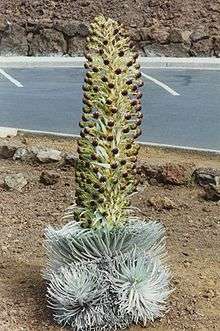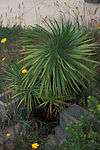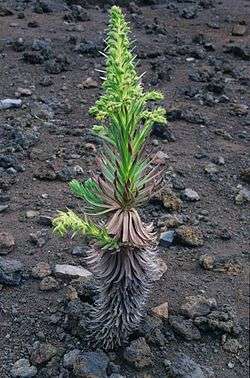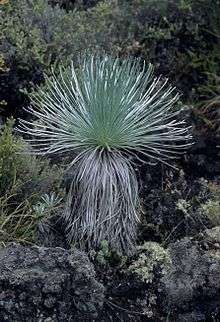Argyroxiphium
Argyroxiphium is a small genus of plants in the sunflower family, Asteraceae.[2][3] Its members are known by the common names of silversword or greensword due to their long, narrow leaves and the silvery hairs on some species. It belongs to a larger radiation of over 50 species, including the physically different genera Dubautia and Wilkesia. This grouping is often referred to as the silversword alliance [4]. Botanist P. H. Raven referred to this radiation as "the best example of adaptive radiation in plants" [5].
| Argyroxiphium | |
|---|---|
 | |
| Haleakalā silversword | |
| Scientific classification | |
| Kingdom: | Plantae |
| Clade: | Tracheophytes |
| Clade: | Angiosperms |
| Clade: | Eudicots |
| Clade: | Asterids |
| Order: | Asterales |
| Family: | Asteraceae |
| Subfamily: | Asteroideae |
| Supertribe: | Helianthodae |
| Tribe: | Madieae |
| Genus: | Argyroxiphium DC. |
| Synonyms[1] | |
|
Argyrophyton Hook. | |
Description
These perennials are endemic to Hawaiʻi, occurring only on the islands of Maui and Hawaiʻi in an extremely localized distribution [6]. They are primarily found above 1,500 m (4,900 ft) in elevation in alpine deserts or bogs, indicating an adaptation to low-nutrient soils. The Kaʻū or Mauna Loa silversword (A. kauense) is the most adaptable: it can be found in rocky lava flows, bogs, and open forest. The evolutionary root of Argyroxiphium stems from Californian Tarweeds [7] by way of DNA evidence which shows they share almost 80% of their DNA evidence. The Tarweed ancestor is thought to have traveled to Hawaii almost 10 million years ago, at which point the Hawaiian flora began diversifying at incredible speed [8].
They consist of rosette-forming epigeal shrubs or dwarf shrubs. They may consist of a single large rosette (Mauna Kea and Haleakalā silverswords), a short-branched rosette (Mauna Loa silversword), or spreading with runners (ʻEke silversword, greenswords). The flower heads consist of a ring of pistillate ray florets around 30 to 600 disk florets. The corolla varies in color from purplish to wine red or yellow, while the anthers are dark. A rosette will grow from 5–20 years before flowering, after which it dies. For those with a single rosette, this means the death of the plant (in contrast, those reproducing by runners rarely flower and may be very long-lived). Because they require cross-pollination by insects, many plants must flower at the same time in relatively close proximity or they will fail to set seed. A significant population must exist for enough to flower each year for pollination to occur. In addition to the distinct rosette feature, the mesophyll perenchyma of the leaves are filled with an interstitial gel of saccharides which promote survival in the harsher environment [9].
Despite their very different appearances, the silverswords are very closely related to the genus Dubautia. Although some Dubautia are radically different from silverswords, those found in wet forests and alpine deserts clearly grade into the form of silverswords. Hybrids between Argyroxiphium sandwicense and Dubautia menziesii are common in Haleakalā Crater. Although the two species are quite distinct, the hybrids span the entire range of variation between them.
Conservation
Silverswords and greenswords are highly sensitive to disturbance. The best-known species, A. sandwicense, has dwindled to 50 plants existing in the wild, due in large part to disturbance by grazing animals introduced to their natural habitat over the past hundred years [10]. Their shallow root systems are easily crushed in the boggy soil or loose volcanic cinders they grow in. The succulent leaves are eaten by goats in the dry summits, and pigs frequently disturb the fragile bog vegetation. All species are highly restricted in range, and even those that are protected are vulnerable to catastrophic events. The East Maui greensword (A. virescens) is apparently extinct, but in 1989 plants were discovered that appear to be hybrids between it and the Haleakalā Silversword.[11] The Mauna Kea and Mauna Loa silverswords both have small populations, but are being cultivated and outplanted in protected areas. The largest population of Mauna Loa silverswords is in Kahuku, which was recently acquired by Hawaii Volcanoes National Park.[12] Botanist L. Walker created a system of ideal conditions in which to outsource the growing and planting of certain Argyroxiphium, which would assist in efforts to bring the species back to the wilderness in strength [13].
Species
- accepted species[1]
- Argyroxiphium caliginis C.N.Forbes – ʻEke silversword
- Argyroxiphium grayanum (Hillebr.) O. Deg. – greensword
- Argyroxiphium × kai D.D.Keck (A. caliginis × A. grayanum)
- Argyroxiphium kauense (Rock & M.Neal) O.Deg. & I.Deg. – Mauna Loa or Kaʻū silversword
- Argyroxiphium sandwicense DC. – silversword
- Argyroxiphium sandwicense ssp. sandwicense DC. – Mauna Kea silversword
- Argyroxiphium sandwicense ssp. macrocephalum (A.Gray) Meyrat – Haleakalā silversword
- Argyroxiphium virescens Hillebr. – East Maui greensword (extinct)
- formerly included[1]
now in Wilkesia
- A. gymnoxiphium - Wilkesia gymnoxiphium
Gallery
 Greensword
Greensword Greensword, Puʻu Kukui bog
Greensword, Puʻu Kukui bog Haleakalā silversword
Haleakalā silversword Silversword in Haleakalā Crater
Silversword in Haleakalā Crater Dubautia-silversword hybrid in Haleakalā Crater
Dubautia-silversword hybrid in Haleakalā Crater Mauna Kea silversword
Mauna Kea silversword Mauna Kea silversword
Mauna Kea silversword Mauna Kea silversword flowering
Mauna Kea silversword flowering- Mauna Kea silversword
 Mauna Loa silversword habitat, Kahuku
Mauna Loa silversword habitat, Kahuku Mauna Loa silversword, multiple rosettes
Mauna Loa silversword, multiple rosettes Mauna Loa silversword, single rosette
Mauna Loa silversword, single rosette_close_up.jpg) Haleakalā silversword (close-up)
Haleakalā silversword (close-up)
References
- Flann, C (ed) 2009+ Global Compositae Checklist
- Candolle, Augustin Pyramus de. 1836. Prodromus Systematis Naturalis Regni Vegetabilis 5: 668
- Tropicos, Argyroxiphium DC.
- [B. Baldwin. Age and Rate of Diversification of the Hawaiian Silversword Alliance (Compositae). 1998.]
- [Raven, P. H. Biology of Plants. 1990]
- [B. Baldwin. Hawaiian Angiosperm Radiations of North American Origin, 2010.]
- [B. Baldwin. Hawaiian Angiosperm Radiations of North American Origin, 2010]
- [B. Baldwin. Age and Rate of Diversification of the Hawaiian Silversword Alliance (Compositae). 1998.]
- [S. Carlquist. Anatomy of Tropical Alpine Plants. 1994.]
- [L. Walker. Regeneration of the Mauna Kea Silversword Argyroxiphium Sandwicense (Asteraceae) in Hawaii. 1997.]
- Carr, Gerald (1997-03-20). "Argyroxiphium virescens Hillebrand". Hawaiian Silversword Alliance. University of Hawaii. Archived from the original on 18 September 2009. Retrieved 2009-11-01.
- Flora of the Hawaiian Islands, Smithsonian Institution National Museum of Natural History,
- [L. Walker. Regeneration of the Mauna Kea Silversword Argyroxiphium Sandwicense (Asteraceae) in Hawaii. 1997.]
External links
| Wikimedia Commons has media related to Argyroxiphium. |
| Wikispecies has information related to Argyroxiphium |